Name Kuyucu Pasha Role Statesman | Died 1611, Diyarbakir, Turkey Children Fatma Hatun | |
 | ||
People also search for Ahmed I, Fatma Hatun, Safiye Sultan | ||
Kuyucu Murad Pasha (Turkish for "Murad Pasha the Well-digger", i.e. "Gravedigger";Bosnian: Murat-paša Kujudžić born in 1535, Bosnia, died 1611, Diyabakir ) was an Ottoman statesman of Croatian origin who served as Grand Vizier of the Ottoman Empire during the reign of Ahmed I between December 9, 1606 and August 5, 1611. He died during the Ottoman-Safavid War (1603-1618).
Contents
Nickname
His nickname derives from the mass graves he had dug to bury the condemned of the harsh methods he employed in order to suppress (and eventually put an end) to the Jelali Revolts, which had created disastrous turmoil in Ottoman Anatolia. Tens of thousands of Anatolians were killed during Murad Pasha's office in his several campaigns against separate large rebel groups.
Career
He was beylerbey in Yemen and Karaman during his early career. He participated in the Long Turkish War and impressed Mehmed III in particular at the Siege of Eger (1596) after which he became military commander of Ottoman Hungary for a while.
Legacy
Murad Pasha had a complex built in Istanbul, about 300 meters northwest of the Bayezid II Mosque on the Third Hill of Istanbul. Today, the complex has been absorbed by Istanbul University, its courtyard having been roofed in and used as a museum for the fine arts, while its library remains operational. The complex also includes Murad Pasha's mausoleum where he was buried after his death in 1611, the walls of whose entrance gate have become darkened due to time. Cleanup on the building has been halted, leading to its current state, because of strong reactions by several Anatolian groups, such as Yörüks, Alevis, and Bektashis, against honoring Murad Pasha, who they hold responsible for killing thousands of members of their groups. Some have suggested that the mausoleum be made into a museum for the massacres and called the government's intention to conduct repairs on the building "shameful" in light of Murad Pasha's legacy. However, Karen Barkey suggests that Murad's methods were standard for the time and were often equalled or exceeded by many predatory rebel leaders (Bandits and Bureaucrats)
